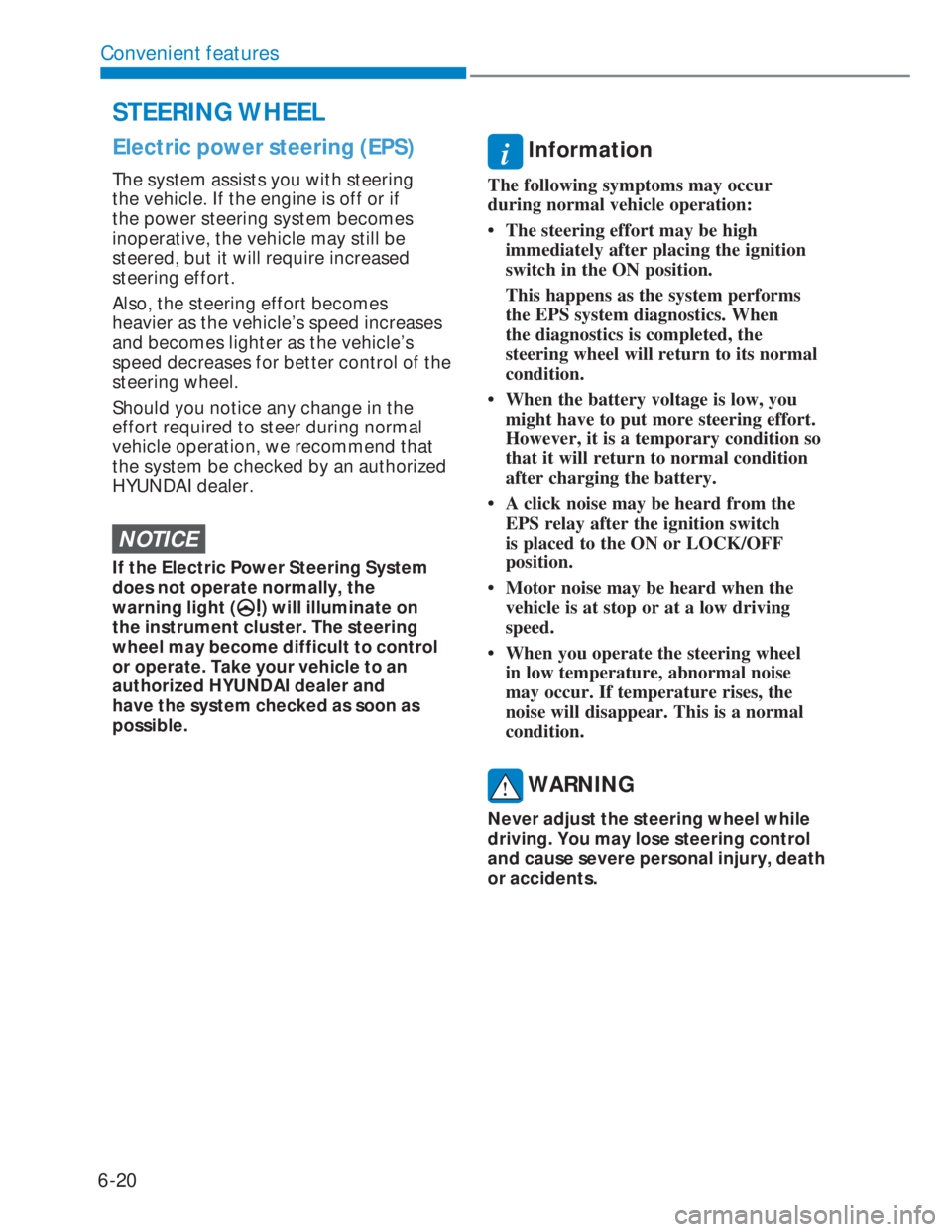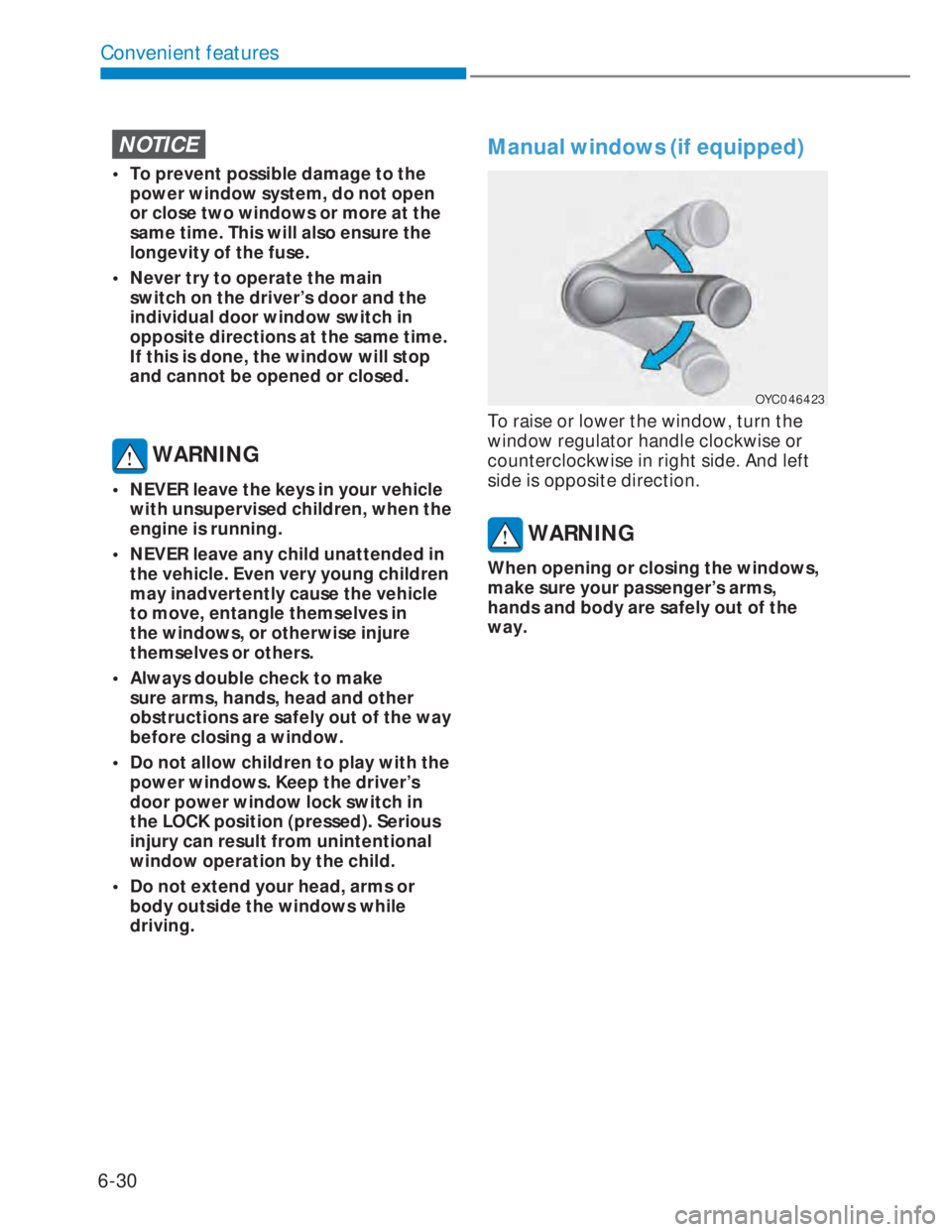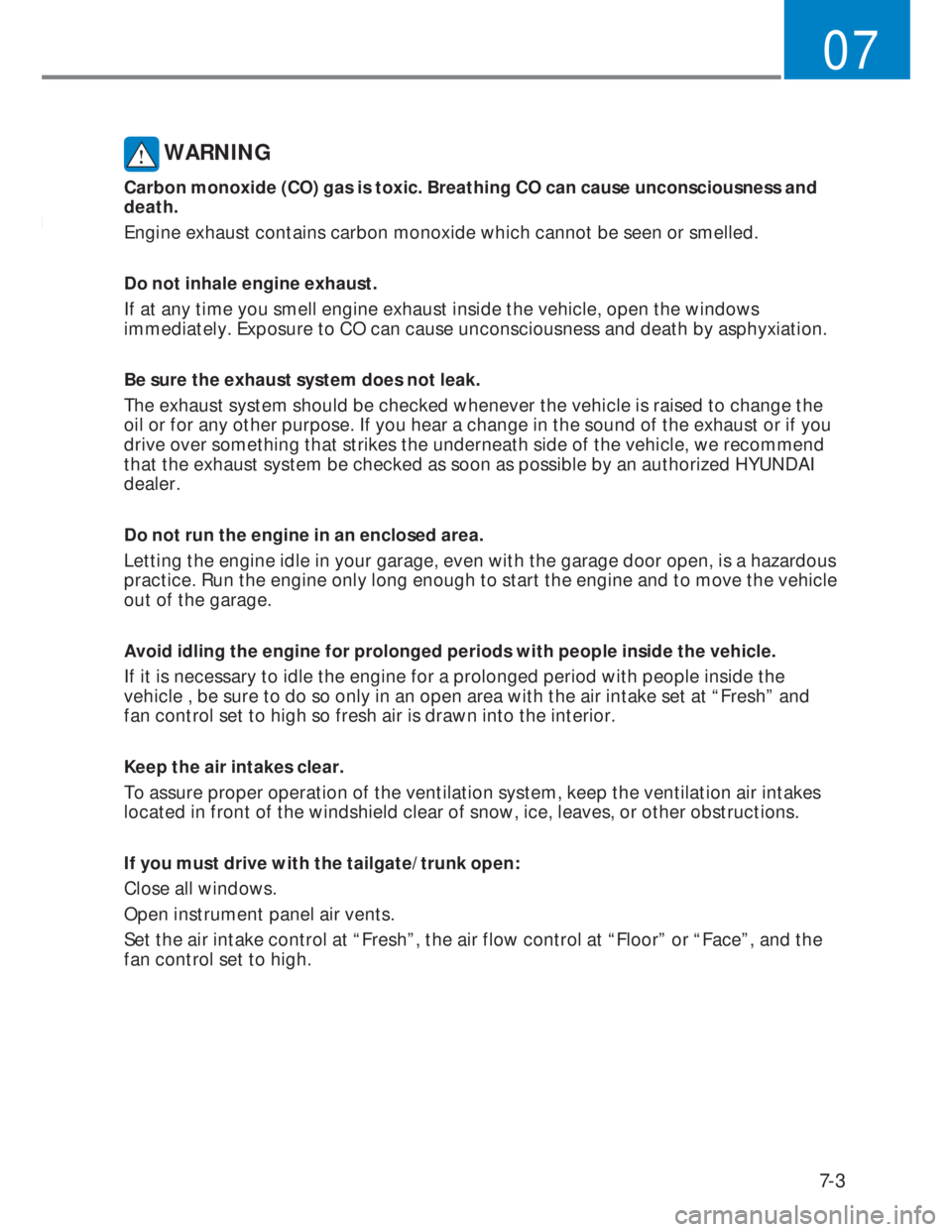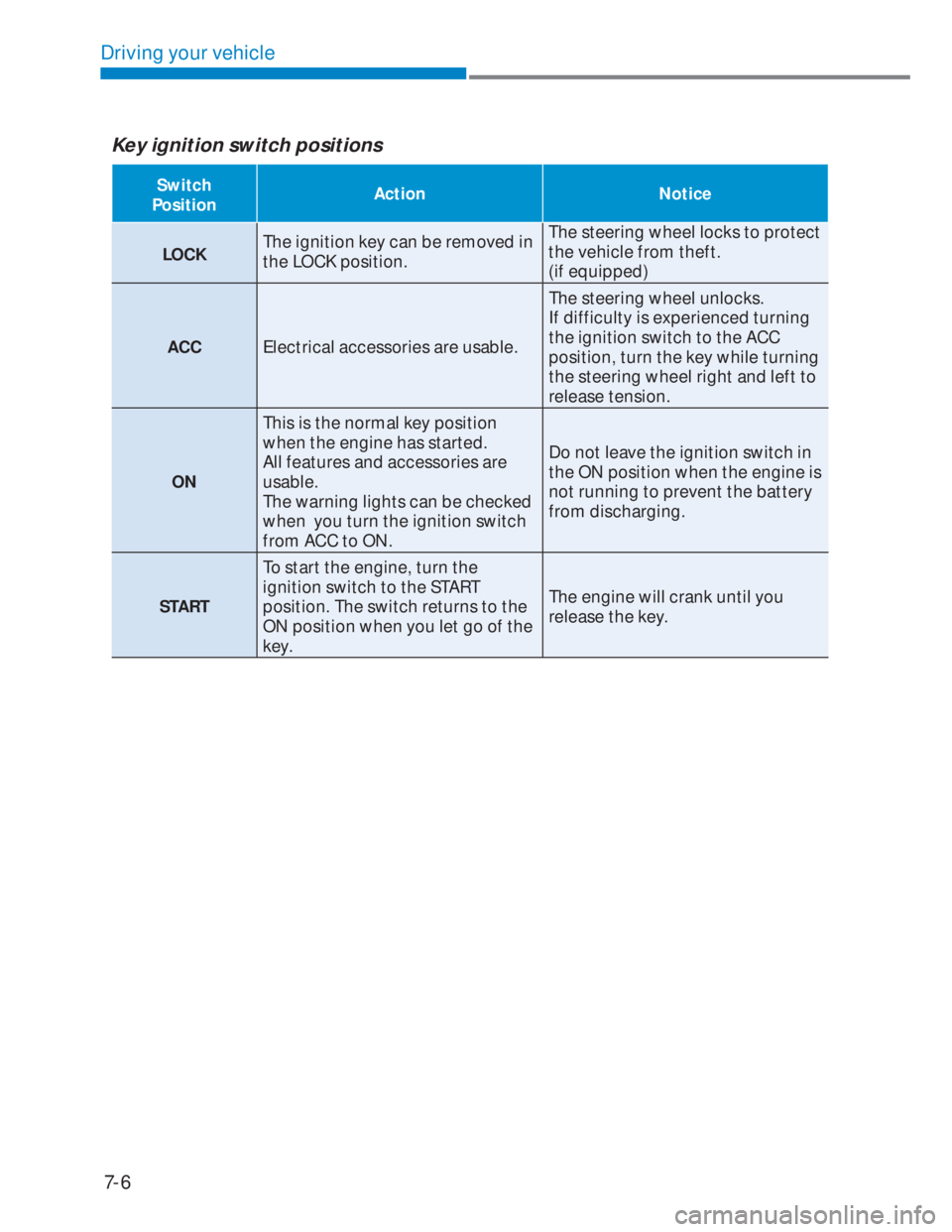check engine HYUNDAI I20 2021 User Guide
[x] Cancel search | Manufacturer: HYUNDAI, Model Year: 2021, Model line: I20, Model: HYUNDAI I20 2021Pages: 444, PDF Size: 8.93 MB
Page 136 of 444

6-8
Convenient features
Locking
OBI3050001OBI3050001
To lock :
1. Close all doors, engine hood and
tailgate.
2. Either press the door handle button or
press the Door Lock button (1) on the
smart key.
3. The hazard warning lights will blink
once.
4. Make sure the doors are locked by
checking the position of the door lock
button inside the vehicle.
i Information
The door handle button will only operate
when the smart key is within 0.7~1 m
(28~40 in.) from the outside door handle. Even though you press the outside
door handle button, the doors will not
lock and the chime will sound for three
seconds if any of the following occur:
• The Smart Key is in the vehicle.
• The Engine Start/Stop button is in ACC
or ON position.
• Any door except the tailgate/trunk is
open.
WARNING
Do not leave the Smart Key in your
vehicle with unsupervised children.
Unattended children could press the
Engine Start/Stop button and may
operate power windows or other
controls, or even make the vehicle
move, which could result in serious
injury or death.
Page 148 of 444

6-20
Convenient features
Electric power steering (EPS)
The system assists you with steering
the vehicle. If the engine is off or if
the power steering system becomes
inoperative, the vehicle may still be
steered, but it will require increased
steering effort.
Also, the steering effort becomes
heavier as the vehicle’s speed increases
and becomes lighter as the vehicle’s
speed decreases for better control of the
steering wheel.
Should you notice any change in the
effort required to steer during normal
vehicle operation, we recommend that
the system be checked by an authorized
HYUNDAI dealer.
NOTICE
If the Electric Power Steering System
does not operate normally, the
warning light (
) will illuminate on
the instrument cluster. The steering
wheel may become difficult to control
or operate. Take your vehicle to an
authorized HYUNDAI dealer and
have the system checked as soon as
possible.
i Information
The following symptoms may occur
during normal vehicle operation:
• The steering effort may be high
immediately after placing the ignition
switch in the ON position.
This happens as the system performs
the EPS system diagnostics. When
the diagnostics is completed, the
steering wheel will return to its normal
condition.
• When the battery voltage is low, you
might have to put more steering effort.
However, it is a temporary condition so
that it will return to normal condition
after charging the battery.
• A click noise may be heard from the
EPS relay after the ignition switch
is placed to the ON or LOCK/OFF
position.
• Motor noise may be heard when the
vehicle is at stop or at a low driving
speed.
• When you operate the steering wheel
in low temperature, abnormal noise
may occur. If temperature rises, the
noise will disappear. This is a normal
condition.
WARNING
Never adjust the steering wheel while
driving. You may lose steering control
and cause severe personal injury, death
or accidents.
STEERING WHEEL
Page 158 of 444

6-30
Convenient features
NOTICE
• To prevent possible damage to the
power window system, do not open
or close two windows or more at the
same time. This will also ensure the
longevity of the fuse.
• Never try to operate the main
switch on the driver’s door and the
individual door window switch in
opposite directions at the same time.
If this is done, the window will stop
and cannot be opened or closed.
WARNING
• NEVER leave the keys in your vehicle
with unsupervised children, when the
engine is running.
• NEVER leave any child unattended in
the vehicle. Even very young children
may inadvertently cause the vehicle
to move, entangle themselves in
the windows, or otherwise injure
themselves or others.
• Always double check to make
sure arms, hands, head and other
obstructions are safely out of the way
before closing a window.
• Do not allow children to play with the
power windows. Keep the driver’s
door power window lock switch in
the LOCK position (pressed). Serious
injury can result from unintentional
window operation by the child.
• Do not extend your head, arms or
body outside the windows while
driving.
Manual windows (if equipped)
OYC046423OYC046423
To raise or lower the window, turn the
window regulator handle clockwise or
counterclockwise in right side. And left
side is opposite direction.
WARNING
When opening or closing the windows,
make sure your passenger’s arms,
hands and body are safely out of the
way.
Page 164 of 444

6-36
Convenient features
Closing the hood
1. Before closing the hood, check the
following:
• All filler caps in engine compartment
must be correctly installed.
• Gloves, rags or any other
combustible material must
be removed from the engine
compartment.
2. Return the support rod to its clip to
prevent it from rattling.
3. Lower the hood halfway (lifted
approximately 30 cm from the closed
position) and push down to securely
lock in place. Then double check to be
sure the hood is secure.
WARNING
Always double check to be sure that the
hood is firmly latched before driving
away. Check there is no hood open
warning light or message displayed on
the instrument cluster. Driving with the
hood opened may cause a total loss
of visibility, which might result in an
accident.
WARNING
• Before closing the hood, ensure that
all obstructions are removed from
the hood opening. Closing the hood
with an obstruction present in the
hood opening may result in property
damage or severe personal injury.
• Do not leave gloves, rags or any other
combustible material in the engine
compartment. Doing so may cause a
heat-induced fire.
• Do not move the vehicle with
the hood raised. The view will be
blocked and the hood could fall or be
damaged.
Tailgate
Opening the tailgate
OBI3050014OBI3050014
• The tailgate is locked or unlocked
when all doors are locked or unlocked
with the key, remote key, smart key or
central door lock/unlock switch.
• If unlocked, the tailgate can be
opened by pressing the handle and
pulling it up.
i Information
In cold and wet climates, door lock and
door mechanisms may not work properly
due to freezing conditions.
Page 169 of 444

6-41
06
• When refueling, always move the
shift lever to the P (Park) position (for
Intelligent Manual Transmission) or
first gear or R (Reverse, for manual
transmission), set the parking brake,
and place the ignition switch to the
LOCK/OFF position. Sparks produced
by electrical components related
to the engine can ignite fuel vapors
causing a fire.
• Do not use matches or a lighter and
do not smoke or leave a lit cigarette
in your vehicle while at a gas station,
especially during refueling.
• Do not over-fill or top-off your
vehicle tank, which can cause petrol
spillage.
• If a fire breaks out during refueling,
leave the vicinity of the vehicle, and
immediately contact the manager
of the gas station and then contact
the local fire department. Follow any
safety instructions they provide.
• If pressurized fuel sprays out, it can
cover your clothes or skin and thus
subject you to the risk of fire and
burns. Always remove the fuel cap
carefully and slowly. If the cap is
venting fuel or if you hear a hissing
sound, wait until the condition stops
before completely removing the cap.
• Always check that the fuel cap is
installed securely to prevent fuel
spillage in the event of an accident.i Information
• Make sure to refuel your vehicle
according to the “Fuel Requirements”
suggested in the 1 chapter.
• Do not spill fuel on the exterior surfaces
of the vehicle. Any type of fuel spilled
on painted surfaces may damage the
paint.
NOTICE
If the fuel filler cap requires
replacement, use only a genuine
HYUNDAI cap or the equivalent
specified for your vehicle. An incorrect
fuel filler cap can result in a serious
malfunction of the fuel system or
emission control system.
Page 188 of 444

6-60
Convenient features
Air conditioning system operation tips
• If the vehicle has been parked in direct
sunlight during hot weather, open the
windows for a short time to let the hot
air inside the vehicle escape.
• After sufficient cooling has been
achieved, switch back from
recirculation mode to fresh mode.
• To help reduce moisture inside of
the windows on rainy or humid
days, decrease the humidity inside
the vehicle by operating the air
conditioning system with the windows
and sunroof closed.
• During air conditioning system
operation, you may occasionally
notice a slight change in engine speed
as the air conditioning compressor
cycles. This is a normal system
operation characteristic.
• Use the air conditioning system
every month only for a few minutes
to ensure maximum system
performance.
• When using the air conditioning
system, you may notice clear water
dripping (or even puddling) on the
ground under the passenger side of
the vehicle. This is a normal system
operation characteristic.
• If you operate the air conditioner
excessively, the difference between
the temperature of the outside air and
that of the windshield could cause the
outer surface of the windshield to fog
up, causing loss of visibility. In this
case, set the mode selection button to
the
position and set the fan speed
control knob to the lowest speed
setting.
System maintenance
Climate control air filter
OIK047401LOIK047401L
[A] : Outside air, [B] : Recirculated air
[C] : Climate control air filter, [D] : Blower
[E] : Evaporator core, [F] : Heater core
This filter is installed behind the glove
box. It filters the dust or other pollutants
that enter the vehicle through the
heating and air conditioning system.
We recommend that the climate control
air filter be replaced by an authorized
HYUNDAI dealer according to the
maintenance schedule. If the vehicle is
being driven in severe conditions such
as dusty or rough roads, more frequent
climate control filter inspections and
changes are required.
If the air flow rate suddenly decreases,
we recommend the system be checked
at an authorized HYUNDAI dealer.
i Information
• Replace the filter according to the
Maintenance Schedule.
• If the car is being driven in severe
conditions such as dusty, rough roads,
more frequent climate control air filter
inspections and changes are required.
• When the air flow rate suddenly
decreases, we recommend that the
system be checked by an authorized
HYUNDAI dealer.
Page 211 of 444

6-83
06
To charge a cellular phone
The wireless cellular phone charging
system charges only the Qi-enabled
cellular phones (
). Read the label on
the cellular phone accessory cover or
visit your cellular phone manufacturer’s
website to check whether your cellular
phone supports the Qi technology.
The wireless charging process starts
when you put a Qi-enabled cellular
phone on the wireless charging unit.
1. Remove other items, including the
smart key, from the wireless charging
unit. If not, the wireless charging
process may be interrupted. Place
the cellular phone on the center of
charging pad.
2. You can turn ON or OFF the wireless
charging function in the User Settings
mode on the instrument cluster. For
further information, refer to the “LCD
Display Modes” in chapter 4.If your cellular phone is not charging:
- Slightly change the position of the
cellular phone on the charging pad.
- Make sure the indicator light is orange.
The ERROR symbol will blink/flash for
10seconds and turn off if there is a
malfunction in the wireless charging
system.
In this case, temporarily stop the
charging process, re-attempt to
wirelessly charge your cellular phone
and then check the charging status
again.
The system warns you with a message
on the LCD display if the cellular phone
is still on the wireless charging unit after
the engine is turned OFF and the front
door is opened.
For some manufacturers’ cellular
phones, the system may not warn you
even though the cellular phone is left on
the wireless charging unit. This is due
to the particular characteristic of the
cellular phone and not a malfunction of
the wireless charging.
CAUTION
To prevent liquid from damaging
the wireless cellular phone charging
system in your vehicle, be sure not to
spill liquid over the pad when charging
your cellular phone.
Page 236 of 444

6-108
Convenient features
3. Enter or confirm the passkey to
confirm the connection.
• If the passkey input screen is
displayed on the Bluetooth device
screen, enter the passkey ‘0000’
which is displayed on the system
screen.
• If the 6-digit passkey is displayed
on the Bluetooth device screen,
ensure that the Bluetooth passkey
displayed on the Bluetooth device
is the same as the passkey on the
system screen and confirm the
connection from the device.
NOTICE
• The screen image in this manual is an
example. Check your system screen
for the exact vehicle name and
Bluetooth device name.
• The default passkey is ‘0000’.
• It may take a while for the system
to connect with the device after
you permit the system to access the
device. When a connection is made,
the Bluetooth status icon appears at
the top of the screen.
• You can change the permission
settings via the mobile phone’s
Bluetooth settings menu. For more
information, refer to your mobile
phone’s user guide.
• To register a new device, repeat
steps 1 to 3.
• If you use the automatic Bluetooth
connection function, a call may be
switched to the vehicle’s Handsfree
when you are taking on the phone
near the vehicle while the vehicle’s
engine is on. If you do not want the
system to connect with the device
automatically, deactivate Bluetooth
on your device.
• When a device is connected to the
system via Bluetooth, the device’s
battery may discharge faster.
Connecting a paired device
To use a Bluetooth device on your
system, connect the paired device to the
system. Your system can connect with
only one device at a time.
1. From the control panel, press the
[PHONE] button, and then select
Phone settings �X Paired devices.
• If there is no connected device,
press the Call/Answer button on the
steering wheel.
2. Turn the [TUNE] knob to select the
device to connect, and then press the
knob.
• If another device is already
connected to your system,
disconnect it. Select the connected
device to disconnect.
NOTICE
• If a connection ends because a
device is out of the connection
range or a device error occurs,
the connection will be restored
automatically when the device
enters the connection range or when
the error is cleared.
• Depending on auto connection
priority, connection to a device may
take time.
Page 250 of 444

7-3
07
WARNING
Carbon monoxide (CO) gas is toxic. Breathing CO can cause unconsciousness and
death.
Engine exhaust contains carbon monoxide which cannot be seen or smelled.
Do not inhale engine exhaust.
If at any time you smell engine exhaust inside the vehicle, open the windows
immediately. Exposure to CO can cause unconsciousness and death by asphyxiation.
Be sure the exhaust system does not leak.
The exhaust system should be checked whenever the vehicle is raised to change the
oil or for any other purpose. If you hear a change in the sound of the exhaust or if you
drive over something that strikes the underneath side of the vehicle, we recommend
that the exhaust system be checked as soon as possible by an authorized HYUNDAI
dealer.
Do not run the engine in an enclosed area.
Letting the engine idle in your garage, even with the garage door open, is a hazardous
practice. Run the engine only long enough to start the engine and to move the vehicle
out of the garage.
Avoid idling the engine for prolonged periods with people inside the vehicle.
If it is necessary to idle the engine for a prolonged period with people inside the
vehicle , be sure to do so only in an open area with the air intake set at “Fresh” and
fan control set to high so fresh air is drawn into the interior.
Keep the air intakes clear.
To assure proper operation of the ventilation system, keep the ventilation air intakes
located in front of the windshield clear of snow, ice, leaves, or other obstructions.
If you must drive with the tailgate/trunk open:
Close all windows.
Open instrument panel air vents.
Set the air intake control at “Fresh”, the air flow control at “Floor” or “Face”, and the
fan control set to high.
Page 253 of 444

7-6
Driving your vehicle
Key ignition switch positions
Switch
PositionAction Notice
LOCKThe ignition key can be removed in
the LOCK position.The steering wheel locks to protect
the vehicle from theft.
(if equipped)
ACCElectrical accessories are usable.The steering wheel unlocks.
If difficulty is experienced turning
the ignition switch to the ACC
position, turn the key while turning
the steering wheel right and left to
release tension.
ONThis is the normal key position
when the engine has started.
All features and accessories are
usable.
The warning lights can be checked
when you turn the ignition switch
from ACC to ON.Do not leave the ignition switch in
the ON position when the engine is
not running to prevent the battery
from discharging.
STARTTo start the engine, turn the
ignition switch to the START
position. The switch returns to the
ON position when you let go of the
key.The engine will crank until you
release the key.